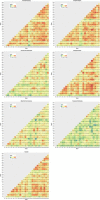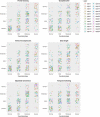A Photo Score For Aesthetic Outcome In Sagittal Synostosis: An ERN CRANIO Collaboration
- PMID: 37702534
- PMCID: PMC10597420
- DOI: 10.1097/SCS.0000000000009732
A Photo Score For Aesthetic Outcome In Sagittal Synostosis: An ERN CRANIO Collaboration
Abstract
European Reference Network (ERN) CRANIO is focused on optimizing care for patients with rare or complex craniofacial anomalies, including craniosynostosis and/or rare ear, nose, and throat disorders. The main goal of ERN CRANIO is to collect uniform data on treatment outcomes for multicenter comparison. We aimed to develop a reproducible and reliable suture-specific photo score that can be used for cross-center comparison of phenotypical severity of sagittal synostosis and aesthetic outcome of treatment. We conducted a retrospective study among nonsyndromic sagittal synostosis patients aged <19 years. We included preoperative and postoperative photo sets from 6 ERN CRANIO centers. Photo sets included bird's eye, lateral, and anterior-posterior views. The sagittal synostosis photo score was discussed in the working group, and consensus was obtained on its contents. Interrater agreement was assessed with weighted Fleiss' Kappa and intraclass correlation coefficients.The photo score consisted of frontal bossing, elongated skull, biparietal narrowness, temporal hollowing, vertex line depression, occipital bullet, and overall phenotype. Each item was scored as normal, mild, moderate, or severe. Results from 36 scaphocephaly patients scored by 20 raters showed kappa values ranging from 0.38 [95% bootstrap CI: 0.31, 0.45] for biparietal narrowness to 0.56 [95% bootstrap CI: 0.47, 0.64] for frontal bossing. Agreement was highest for the sum score of individual items [intraclass correlation coefficients agreement 0.69 [95% CI: 0.57, 0.82]. This is the first large-scale multicenter study in which experts investigated a photo score to assess the severity of sagittal synostosis phenotypical characteristics. Agreement on phenotypical characteristics was suboptimal (fair-moderate agreement) and highest for the summed score of individual photo score items (substantial agreement), indicating that although experts interpret phenotypical characteristics differently, there is consensus on overall phenotypical severity.
Copyright © 2023 The Author(s). Published by Wolters Kluwer Health, Inc. on behalf of Mutaz B. Habal, MD.
Conflict of interest statement
The authors report no conflicts of interest.
Figures




References
-
- https://erncranio.eu/ ERN CRANIO website. Assessed 10 December 2021.
-
- Mathijssen IM, van Splunder J, Vermeij-Keers C, et al. . Tracing craniosynostosis to its developmental stage through bone center displacement. J Craniofac Gen Develop Biol 1999;19:57–63 - PubMed
-
- Wes AM, Naran S, Sun J, et al. . The Whitaker Classification of Craniosynostosis Outcomes: An assessment of interrater reliability. Plast Reconstr Surg 2017;140:579e–586ee - PubMed
-
- Whitaker LA, Bartlett SP, Schut L, et al. . Craniosynostosis: an analysis of the timing, treatment, and complications in 164 consecutive patients. Plast Reconstr Surg 1987;80:195–212 - PubMed
Publication types
MeSH terms
LinkOut - more resources
Full Text Sources

